How to make a spark arrestor for a chimney with your own hands: a step-by-step guide
In addition to its advantages, individual heating has a significant drawback - the risk of fire.The risk of fire increases significantly when the combustion process reaches high temperatures and fiery sparks fly out of the chimney with great force.
A spark arrester on the chimney will help solve this problem - the device prevents the spread of dangerous sparks. The device has a simple design, so it is quite possible to make and install it yourself.
We will tell you how the spark arrester works, describe the features of different models, and provide step-by-step instructions on how to manufacture and fasten the element. The information presented will help you complete all the work yourself, saving money on purchasing a finished product and calling a specialist.
The content of the article:
A few words about the structure and operation of the device
A spark extinguisher placed on the chimney will be a real godsend, especially if the house or bathhouse is located next to a forest. After all, hot sparks in windy weather can easily cover a 300-meter distance to a nearby pine tree.
And this is a direct threat of fire, from which you should insure yourself and your property by installing a protective device on the chimney.
Why do you need a spark arrester?
A device for extinguishing sparks is necessary if materials were used for the roof that can easily catch fire if a spark hits them. Of course, such a decorative coating is not the best choice.But in practice, safety is often neglected in order to implement an original design idea.
A spark arrester is needed if there is a bathhouse, sauna or other structure in the local area where it is planned to heat up to a high temperature. The wood from which the walls of the bathhouse are made can easily catch fire from an accidental spark.
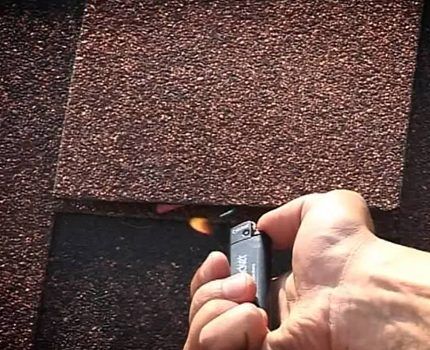
And of course, when the house is equipped with a private heating and hot water supply system. Here the boiler will be heated to a high temperature to meet the heat and hot water needs. Without installing a spark arrestor when arrangement of the chimney can't get by here.
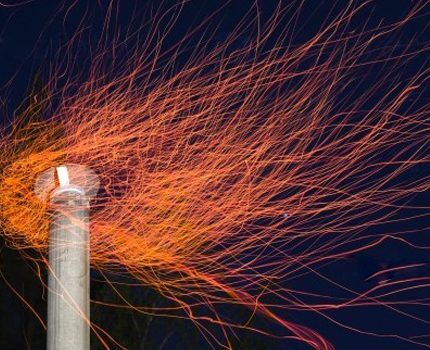
The structure and principle of operation of the spark arrester
The device for extinguishing sparks has a simple structure and a clear operating principle. Depending on the model of the spark arrester, its structure and appearance will differ.
But, in all options, the common feature will be the presence of a metal element made of mesh or a solid sheet. Also, there is a base on which all other parts are attached and a cover that prevents the free flight of sparks.
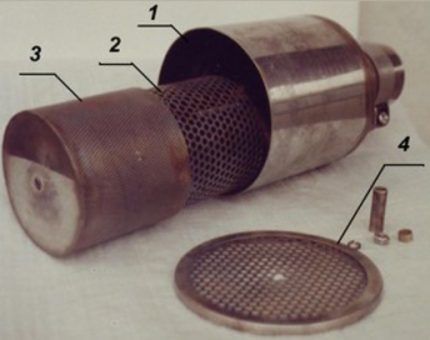
The principle of operation of a spark arrester is to prevent the free movement of sparks flying along chimney pipe. This is facilitated by its structure, which ensures multiple changes in the direction of movement of the spark as it encounters various obstacles.
So, hitting a metal mesh with small cells, the spark breaks, its speed decreases, and the direction of movement changes. If the spark collides with another obstacle on the metal surface of the structure again, it may go out completely without ever flying out of the chimney.
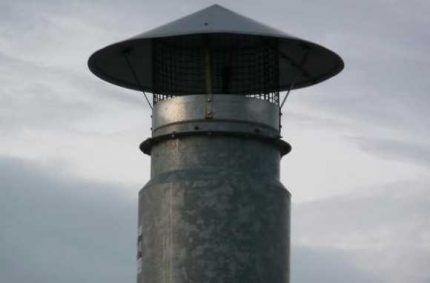
A stainless steel mesh with small cells can prevent sparks, but it will not in any way affect the free movement of gases outside the chimney.
Types of devices for extinguishing sparks
Spark arrestors come in different shapes and sizes. And the element itself responsible for extinguishing sparks is different. Moreover, you can buy a ready-made spark arrester for the chimney in the store or make it yourself. It all depends on skill and personal desire.

You can buy a ready-made spark arrester for installation on a chimney, choosing the most attractive model. Fortunately, manufacturers offer a variety of options, differing not only in appearance, but also in price.
Moreover, the better the performance of the material used in the manufacture of the device, the more expensive its cost will be.

The most commonly used spark arresters are:
- a cap made of metal mesh on the head of the pipe;
- deflector with metal mesh;
- deflector with a skirt for extinguishing sparks.
These are the most popular options for spark arresters, which are easy to build with your own hands if you wish. And a simple structure will be beneficial when making a product yourself. You just need to prepare properly and make preliminary measurements.
A variety of solutions for extinguishing sparks allows you to choose the most suitable option for your chimney. Moreover, not only in appearance, but also in price, which is an important factor when choosing a model.
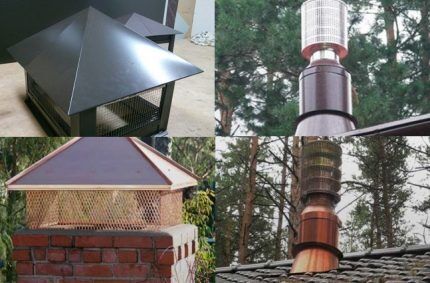
Step-by-step construction of a spark arrestor
To assemble a spark extinguishing device yourself, you will need simple materials, tools and a couple of hours of free time. Moreover, you can choose the optimal model, shape and size.And the choice of material is unlimited - the quality of the final device will be an order of magnitude higher than that of a purchased one.
Selection of model and materials
First you need to decide which model will serve as a spark arrestor. The consumption of materials, the necessary tools and the time spent to manufacture the device will depend on this.
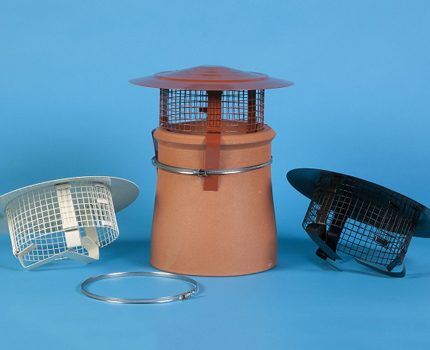
When you need to make a spark arrester with deflector functions, you need:
- take measurements from the inner surface of the chimney - diameter;
- prepare stainless steel metal sheets, pipes;
- if necessary, buy a metal mesh with the required cells;
- prepare tools - metal scissors, grinder, drill, pliers, hammer, pencil, compass, riveter, ruler, paper;
- purchase a metal clamp of the required diameter and rivets.
If you have a rolling machine, the product will turn out almost like a factory one. Otherwise, don’t be upset - all the work can be done with a hammer.
Also, if you don’t have a riveter, you can use a welding machine. The main thing is not to burn unnecessary holes in the process of connecting the joints.
When choosing a material, preference should be given to stainless steel sheets. Moreover, they can be solid or perforated, which can be used instead of metal mesh. The sheet thickness should not exceed 5 mm - thicker material will be difficult to work with.
It is also better to take a metal mesh from stainless steel, giving preference to one with a cell size of 4-5 mm. Larger openings are not as effective at stopping sparks, and openings that are too small can prevent gases and smoke from moving freely.

Making a spark arrestor prototype
When the model of the spark arrester has been selected, you can begin to draw it on paper according to pre-taken measurements. For this you will need a sheet of paper, a compass, a pencil, and a ruler. It is important to do everything in full size and carefully - this will later be used as a prototype of the finished product.
When all the details are drawn on paper, you should add 1-2 cm along the edges - these are allowances for connecting the parts of the parts together.

Afterwards, you need to cut out the paper prototype with scissors and assemble everything - this will allow you to evaluate the appearance of the future product. It is at this stage that adjustments can be made.If everything suits you and the pipe diameter is suitable, then you can begin to outline these parts on metal material.
Assembling the product yourself
After sketching, the necessary parts from which the spark arrester will be assembled should be carefully cut out with metal scissors. This will most likely be an umbrella, stainless steel umbrella holder strips, a mesh cylinder, and a piece of metal pipe of the required diameter.
If you forgot to buy a pipe, you can cut out the required part from a solid sheet of stainless steel and assemble it using a rivet mechanism with rivets.
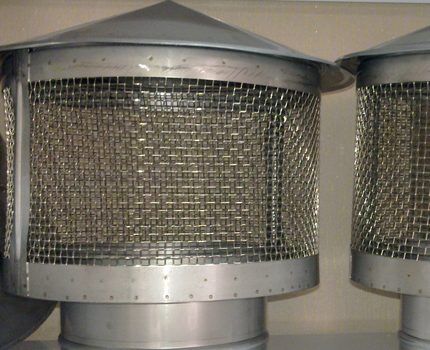
Then you have to assemble all the parts one by one and fasten them together using a riveter. If you don’t have such a tool, you can use a welding machine to make the connection. In this case, seam allowances will be required less than 2 cm, and in order for the seam to have an attractive appearance, it will have to be additionally processed with a grinder.
When assembling a spark arrester, it is important to take into account the features of a particular model. If it is just a spark arrester without a deflector function, then there should be no gaps between the parts - all sparks flying out of the chimney must encounter an obstacle in their path.

When assembling a spark arrester with a deflector function, you must first build your own deflector. Afterwards, in the lower part of the base, at a distance of 6 cm from the lower edge of the upper glass, make holes with a drill for connection with the skirt.
The part is made from a stainless steel sheet in the shape of a plate with raised outer edges.
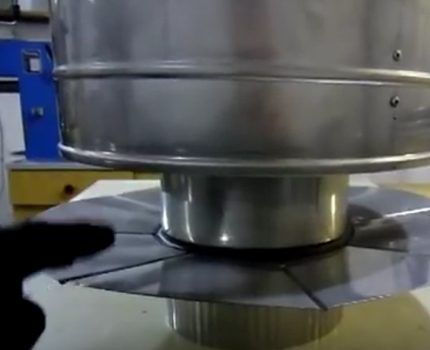
Sometimes home craftsmen, instead of building a spark extinguisher, improve the chimney.
The types of manipulations depend on the type and shape of the pipe:
- holes are made in the metal one in the upper part, and the head is completely covered with a solid stainless steel lid;
- if the chimney is square, then simply attach a metal mesh on top;
- reduce the draft slightly by closing the valve to reduce sparking.
The first option is the most labor-intensive. And the holes will still become clogged with soot over time and will require cleaning. Therefore, it is better to choose an option in which the spark arrester can be easily removed.
Installing and securing the device
When the work on assembling the spark arrester is completed, the last stage lies ahead - installing it on the chimney. To do this, you will need to climb onto the roof, and if the height of the pipe is quite large, then you will need to invite an assistant.
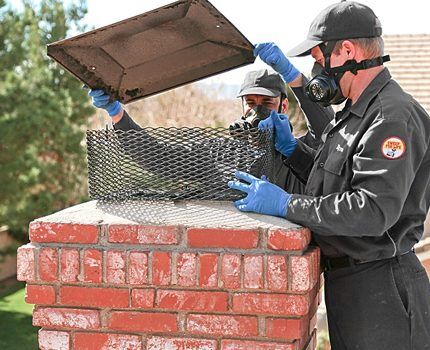
For installation you will need a rivet mechanism or a metal clamp. Sometimes you can find advice from craftsmen who suggest not to fool your head and simply weld a spark arrester to the chimney pipe. This is bad advice - according to fire safety rules, this structural element must be removable.
Therefore, it is best to use a clamp of the required diameter, which will help securely secure the spark arrester to the chimney pipe.

If rivets are used during installation, then holes are made in advance at the required distance on the pipe and on the spark arrester itself. Then the product itself is put on the chimney and the rivets are placed using a riveter. It's good that they are made of stainless steel. This will extend the service life.
Features of spark arrester care
The difficulty of maintaining a spark extinguishing device installed on a chimney depends on the model chosen by the building owner.
First option - a hat made of metal mesh. In this case, you will need to periodically check its condition - it may become clogged with combustion products or other debris blown by the wind.
Such a grid, especially when fuel with a high tar content was used for the fire, must be cleaned of soot and burning quite often. Also, if the material for manufacturing was chosen cheaper, the spark arrester will soon need to be replaced with a new one.

Frequent walks to the roof to clean the mesh can also hardly be called a pleasant experience. Moreover, when from time to time you need to change the metal mesh on the chimney. Therefore, it is better to immediately select a higher quality material for the manufacture of a spark arrester.
Second option – deflector with mesh inside. Here you will also need to periodically clean the metal mesh cells that become clogged with combustion products. After all, the more debris the mesh element of the device collects, the more difficult the process of removing smoke will become. And this is fraught with big troubles.
Third option — deflector with a skirt. Here you have to periodically check that leaves, butterflies and birds do not cover the small holes designed to remove water from rain and melted snow. There is no need to remove the device from its workplace and clean it. This is the easiest model to maintain.
Fourth option — spark arresters made of metal alloys susceptible to corrosion. Such products will very quickly become unusable. This must be taken into account at the material selection stage.
To protect yourself from the need to build a spark arrester every year, it is better to immediately choose high-quality stainless steel with a thickness of 5 mm. The same applies to metal mesh - it must be wear-resistant, preferably made of stainless steel.

The spark arrester must be checked when chimney cleaning.
Conclusions and useful video on the topic
As a spark arrestor, you can use a deflector, in which an additional protective plate is installed - a skirt with raised edges that encircles the device. About this model in the video:

About the features of the spark arrester and its structure in the video clip:

A step-by-step improvement to the deflector, which makes an excellent spark arrestor. The video will tell you what you need for this:

Review of the finished model of a mesh spark absorber, which is completely ready for installation on the chimney, in the video clip:

A spark suppressor for a chimney is a vital device that can protect property and people’s lives. And the price is not bad - especially since you can make a spark arrester with your own hands using scrap materials.
This precaution will help protect your home from accidental fire. After all, the sparks flying out of the chimney will go out as they travel through this metal device.
Do you have any questions or want to share your personal experience in making a spark arrestor for a chimney? Please leave comments on this article. You can attach a photo of your homemade product to your review - the contact form is located below.



